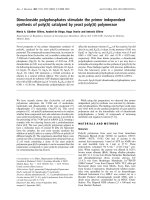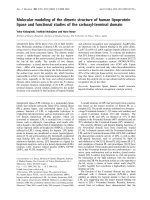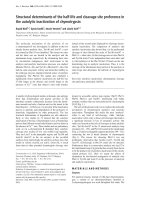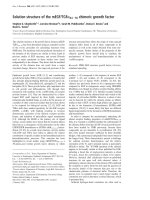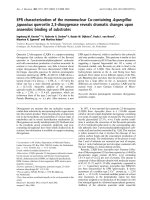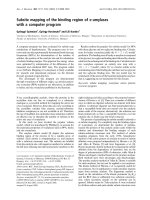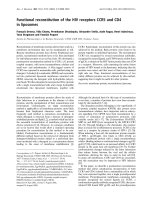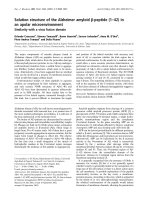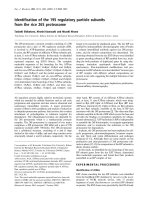Báo cáo y học: "Diagnosing sepsis: does the microbiology matter" pps
Bạn đang xem bản rút gọn của tài liệu. Xem và tải ngay bản đầy đủ của tài liệu tại đây (40.04 KB, 2 trang )
Page 1 of 2
(page number not for citation purposes)
Available online />Abstract
Sepsis is caused by infection, and knowing what type of organism
is causing the infection certainly matters in terms of both
epidemiology and selecting antibiotic therapy. Although there is
considerable laboratory evidence that micro-organisms initiate
sepsis in different ways, the clinical consequences are usually
indistinguishable. New drugs that target specific points in the
activation pathway are starting to emerge, and these will require us
to be much more accurate in how we diagnose sepsis.
Given the time and attention devoted to sepsis in most
intensive care units and the amount of antibiotics that are
prescribed for what is by common consent a disease caused
by micro-organisms, the title of the paper by Gao and
coworkers [1] in this issue of Critical Care might seem a little
curious. Knowing whether the infecting organism is Strepto-
coccus pneumoniae or Escherichia coli quite clearly matters
when it comes to prescribing antibiotics. It is intuitively the
case that patients who are treated with antibiotics that are
effective against the causative organism are more likely to do
well than if they are treated with an ineffective agent - an
impression confirmed by a number of observational studies
[2,3]. Indeed, a recent paper [4] went further and demon-
strated that it was not only the choice of antibiotics but also
the speed with which they were given that was crucial;
delaying the start of treatment, even by as little as 1 hour,
increases the chance of a poor outcome. Identifying the
organism is also important for epidemiological reasons [5].
For instance, it clearly matters whether the patient’s wound
abscess is caused by a fully sensitive Staphylococcus aureus
or a methicillin-resistant S. aureus, not just because antibiotic
therapy (if indicated) would be different, but also because we
might wish to isolate the patient with methicillin-resistant S.
aureus or at least use enhanced infection control practices.
However, the real question posed by Gao and coworkers is
whether knowing the micro-organism ‘matters’ in terms of
either the clinical course of the illness or response to
treatment, and this is considerably less clear.
There is no doubt that different micro-organisms initiate what
we call ‘sepsis’ in different ways. Bacteria have a wide range
of components that can injure the host, and these
components vary fundamentally. For instance, Gram-negative
bacteria have lipopolysaccharide (endotoxin) in their cell wall
but Gram-positive bacteria do not; instead, many of them
produce soluble exotoxins. Certain bacteria have rather
specific virulence mechanisms; for example, the O157 strains
of E. coli produce the verocytotoxin that is associated with
haemolytic-uraemic syndrome, and certain strains of S. aureus
produce toxic shock syndrome toxin-1, which is indelibly
associated with the tampon-associated syndrome (although it
is now known to cause disease in other settings too). These
different virulence mechanisms engage with the host in
different ways, and indeed the past 10 years has seen a quite
remarkable dissection of the innate immune response to
severe infection [6]. Most striking has been the opportunity
afforded by advances in gene profiling to demonstrate that
exposing human cells and tissues to different types of
bacteria elicits different patterns of gene activation [7], which
is perhaps the clearest evidence yet that the infecting
organism does indeed ‘matter’.
However, the uncomfortable reality is that with few excep-
tions we cannot tell from the end of the bed whether the
patient’s nosocomial pneumonia is due to S. aureus or E. coli,
and we certainly cannot tell whether it is caused by Klebsiella
pneumoniae or Pseudomonas aeruginosa. Furthermore,
apart from ensuring that we choose the appropriate antibiotic,
there are no differences in the way that we would treat the
patient. It seems that the clinical picture of sepsis is in effect
a ‘final common pathway’ that results from activation of the
host response to overwhelming infection; by the time we see
it, it is no longer possible to differentiate the process that
initiated it. This reality is nicely illustrated by a recent paper
[8] that looked at gene expression profiles in a clinical rather
than laboratory setting. Although profiles were clearly
different in septic compared to control patients, the investi-
Commentary
Diagnosing sepsis: does the microbiology matter?
Jonathan Cohen
Division of Clinical Medicine, Brighton & Sussex Medical School, Brighton Falmer BN1 9PX, UK
Corresponding author: Jonathan Cohen,
Published: 6 May 2008 Critical Care 2008, 12:145 (doi:10.1186/cc6881)
This article is online at />© 2008 BioMed Central Ltd
See related review by Gao et al., />Page 2 of 2
(page number not for citation purposes)
Critical Care Vol 12 No 2 Cohen
gators could not distinguish Gram-positive from Gram-
negative sepsis. As Fry pointed out in an accompanying
editorial [9], it looks as though sepsis is a ‘generic’ response
to infection.
That goes to the heart of a debate that has been frustrating
clinicians for too long. Sepsis is a real phenomenon - we see
it every day in the intensive care unit - but it is too generic
(diverse) to have a meaningful pathophysiological description
or definition [10]. If instead we were to ask, ‘Pneumonia -
does the nature of the infecting organism matter?’, we would
get a very clear and unambiguous answer. As long as there is
no real evidence that knowing the organism is important in
terms of selecting specific adjunctive therapy, the debate is
moot. However, as soon as we identify a form of therapy that
is specific to the type of infection - an effective anti-endotoxin,
for example, or a Toll-like receptor blocker that preferentially
blocks activation by Gram-positive bacteria - then it will be
time to describe patients’ infections much more accurately:
E. coli pneumonia or staphylococcal empyema [11]. ‘Sepsis’
will still be a useful term, but it will no longer be fit for purpose.
Competing interests
The author declares that they have no competing interests.
References
1. Gao H, Evans TW, Finney SJ: Bench-to-bedside review: Sepsis,
severe sepsis, and septic shock – does the nature of the
infecting organism matter? Crit Care 2008, 12:212.
2. Garnacho-Montero J, Garcia-Garmendia JL, Barrero-Almodovar A,
Jimenez-Jimenez FJ, Perez-Paredes C, Ortiz-Leyba C: Impact of
adequate empirical antibiotic therapy on the outcome of
patients admitted to the intensive care unit with sepsis. Crit
Care Med 2003, 31:2742-2751.
3. Harbarth S, Garbino J, Pugin J, Romand JA, Lew D, Pittet D: Inap-
propriate initial antimicrobial therapy and its effect on survival
in a clinical trial of immunomodulating therapy for severe
sepsis. Am J Med 2003, 115:529-535.
4. Kumar A, Roberts D, Wood KE, Light B, Parrillo JE, Sharma S,
Suppes R, Feinstein D, Zanotti S, Taiberg L, Gurka D, Kumar A,
Cheang M: Duration of hypotension before initiation of effec-
tive antimicrobial therapy is the critical determinant of survival
in human septic shock. Crit Care Med 2006, 34:1589-1596.
5. Llewelyn MJ, Cohen J: Tracking the microbes in sepsis:
advancements in treatment bring challenges for microbial
epidemiology. Clin Infect Dis 2007, 44:1343-1348.
6. Remick DG: Pathophysiology of sepsis. Am J Pathol 2007,
170:1435-1444.
7. Feezor RJ, Oberholzer C, Baker HV, Novick D, Rubinstein M,
Moldawer LL, Pribble J, Souza S, Dinarello CA, Ertel W, Ober-
holzer A: Molecular characterization of the acute inflammatory
response to infections with gram-negative versus gram-posi-
tive bacteria. Infect Immun 2003, 71:5803-5813.
8. Tang BM, McLean AS, Dawes IW, Huang SJ, Cowley MJ, Lin RC:
Gene-expression profiling of Gram-positive and Gram-nega-
tive sepsis in critically ill patients. Crit Care Med 2008, 36:
1125-1128.
9. Fry DE: The generic septic response. Crit Care Med 2008, 36:
1369-1370.
10. Levy MM, Fink MP, Marshall JC, Abraham E, Angus D, Cook D,
Cohen J, Opal SM, Vincent JL, Ramsay G; SCCM/ESICM/ACCP/
ATS/SIS: 2001 SCCM/ESICM/ACCP/ATS/SIS International
sepsis definitions conference. Crit Care Med 2003, 31:1250-
1256.
11. Carlet J, Cohen J, Calandra T, Opal S, Masur H: Sepsis: time to
reconsider the concept. Crit Care Med 2008, 36:964-966.

